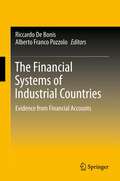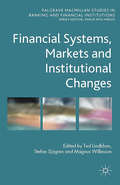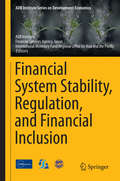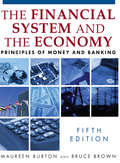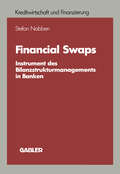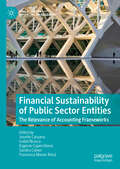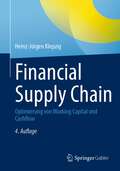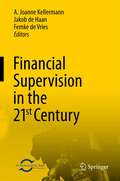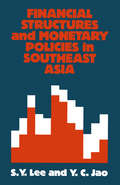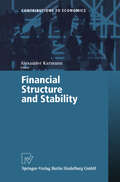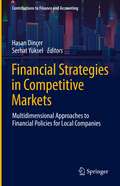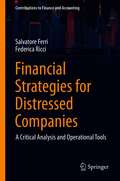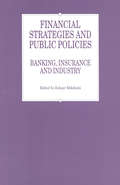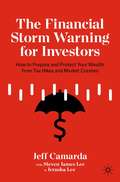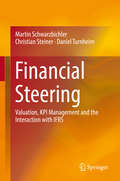- Table View
- List View
The Financial Systems of Industrial Countries: Evidence from Financial Accounts
by Riccardo De Bonis and Alberto Franco PozzoloThis book offers a comprehensive overview of the financial systems of major industrialized countries using the statistical framework of the financial accounts. After a discussion of how economists agreed to create a framework to monitor the financial linkages between surplus and deficit sectors, the book analyzes in detail the composition and the recent evolution of financial assets and liabilities for households (including public pension rights), firms and intermediaries. Next, the volume studies the convergence patterns of financial structures and their influence on the effectiveness of monetary policy within European countries. The final chapter unifies the previous pictures, showing how the effects of financial integration and global imbalances could have been foreseen based on the financial accounts. The analysis and information contained in the book will help the readers to understand many issues and challenges raised by the recent financial crisis.
Financial Systems, Markets and Institutional Changes (Palgrave Macmillan Studies in Banking and Financial Institutions)
by Stefan Sjögren Ted Lindblom Magnus WillessonThis book analyses how the financial system adjusts to institutional changes such as new technology, political tendencies, cultural differences, new business models, and government interactions. It emphasises how different institutional settings affect firms' borrowing and increases our understanding of how efficient financial markets are formed.
Financial Systems: Principles and Organization
by Edwin H. NeaveAs the world's financial markets become increasingly integrated and competitive Financial Systems: Principals and Organization offers an explanation of how and why change occurs. Data from four major financial systems are used to highlight principal financial system features. There is also a detailed exploration of the economic principles behind financial deals. It also offers: * Wider scope than other books on the subject making it an ideal introductory text * More up-to-date economic explanations * An international overview of US, Pacific and European economies This book has already been adopted by the Canadian Institute of Bankers for its financial systems course offered worldwide. Financial Systems will be invaluable reading for students and professionals alike.
Financial Systems: Principles and Organization
by Edwin H. NeaveAs the world's financial markets become increasingly integrated and competitive Financial Systems: Principals and Organization offers an explanation of how and why change occurs. Data from four major financial systems are used to highlight principal financial system features. There is also a detailed exploration of the economic principles behind financial deals. It also offers: * Wider scope than other books on the subject making it an ideal introductory text * More up-to-date economic explanations * An international overview of US, Pacific and European economies This book has already been adopted by the Canadian Institute of Bankers for its financial systems course offered worldwide. Financial Systems will be invaluable reading for students and professionals alike.
Financial System Stability, Regulation, and Financial Inclusion (ADB Institute Series on Development Economics)
by Springer Fachmedien Wiesbaden Staff ADB Institute Staff Financial Services Agency Editors International Monetary Fund StaffFinancial authorities face a number of key challenges, including maintaining financial stability; ensuring long-term finance for stable economic growth; promoting greater access to financial services for both households and small and medium-sized enterprises (SMEs); and fostering a competitive financial industry. Access to finance for SMEs is particularly important, given their large shares in economic activity and employment in Asian economies. Striking the appropriate balance in achieving these objectives through financial supervision and regulation is an important policy issue for financial regulators. This book is the record of a joint conference in 2014 organized by the Asian Development Bank Institute; Financial Services Agency, Japan; and International Monetary Fund Regional Office for Asia and the Pacific on the topic of financial system stability, regulation, and financial inclusion. Participants included noted scholars, policymakers, and financial industrial participants from Asia. ADB InstituteThe ADB Institute, located in Tokyo, is the think tank of the Asian Development Bank. Its mission is to identify effective development strategies and improve development management in ADB’s developing member countries. Financial Services Agency, JapanThe Financial Services Agency, Japan is responsible for ensuring the stability of Japan’s financial system, the protection of depositors, insurance policyholders and securities investors, and smooth finance through such measures as planning and policymaking. International Monetary Fund Regional Office for Asia and the PacificThe International Monetary Fund Regional Office for Asia and the Pacific contributes to economic surveillance and research, leads the IMF’s involvement in regional cooperation, manages regional capacity building programs, and promotes the understanding and two-way dialogue of the IMF in the region.
Financial System of the Economy: Principles of Money and Banking
by Maureen Burton Bruce BrownAttempts to assess whether the United States is in economic decline. Appropriate to general readers as well as economics students and scholars, this book examines the fears of Americans about their economic future.
Financial System of the Economy: Principles of Money and Banking
by Maureen Burton Bruce BrownAttempts to assess whether the United States is in economic decline. Appropriate to general readers as well as economics students and scholars, this book examines the fears of Americans about their economic future.
Financial Swaps: Instrument des Bilanzstrukturmanagements in Banken (Schriftenreihe für Kreditwirtschaft und Finanzierung #6)
by Stefan NabbenFinancial Sustainability of Public Sector Entities: The Relevance of Accounting Frameworks (Public Sector Financial Management)
by Josette Caruana Isabel Brusca Eugenio Caperchione Sandra Cohen Francesca Manes RossiThis book analyses the role of public sector accounting, and the relevance of accounting frameworks, in assisting financially sustainable policy making. Focussing on the European context, the book examines financial reporting, management accounting, budgeting and other reporting requirements, for example, Government Finance Statistics. It also analyses emerging forms of reporting, such as popular reporting and integrated reporting, which may also be considered by policy makers, standard setters, and managers of public sector entities.
Financial Sustainability of Pension Systems: Empirical Evidence from Central and Eastern European Countries (Financial and Monetary Policy Studies #52)
by Stefania Amalia Jimon Florin Cornel Dumiter Nicolae BaltesThe sustainability of public pension systems has become an important aspect for governments and institutions worldwide. This book addresses the multiple elements that influence the sustainability of pension systems with a special focus on central and eastern European countries. Supported by the results of econometric empirical studies, the authors discuss and analyse areas like social economy versus capitalist economy, globalization versus glocalization, population aging versus birth and fertility, emigration versus immigration, early retirement versus prolongation versus professional activity, the sustainability of public pension systems versus the adequacy of benefits provided, public pension systems compared to private pension funds and taxation of salary incomes versus subsidization of state social insurance.
Financial Sustainability in US Higher Education: Transformational Strategy in Troubled Times
by Marcel J. DumestreThis book is a practical approach to insuring financial sustainability of US colleges, presented through the lens of organizational strategic thinking. The book does not simply offer models of how colleges can become financially sustainable in cost cutting, online education, international student recruiting, etc. Rather, it presents a succinct historical perspective of how foundational problems emerged, how some universities transformed themselves, and introduces an organizational strategic thinking process that can be used to develop unique solutions for almost any institution.
Financial Sustainability in Public Administration: Exploring the Concept of Financial Health
by Manuel Pedro Rodríguez BolívarThis book analyses the methods used to assess financial sustainability as defined by the International Federation of Accountants (IFAC). Recently, there have been calls to consider sustainability as a fundamental guiding principle in public management. The financial and economic crisis has spurred a demand for greater financial sustainability in public administrations. Although the concept of sustainability has been traditionally associated with three dimensions (environmental, social and economic), this book is focuses on the metrics used to evaluate financial sustainability and explores the concept of financial health. It will be of interest to researchers and academics in the field of financial sustainability.
Financial Sustainability in Public Administration: Exploring the Concept of Financial Health
by Manuel Pedro Rodríguez BolívarThis book analyses the methods used to assess financial sustainability as defined by the International Federation of Accountants (IFAC). Recently, there have been calls to consider sustainability as a fundamental guiding principle in public management. The financial and economic crisis has spurred a demand for greater financial sustainability in public administrations. Although the concept of sustainability has been traditionally associated with three dimensions (environmental, social and economic), this book is focuses on the metrics used to evaluate financial sustainability and explores the concept of financial health. It will be of interest to researchers and academics in the field of financial sustainability.
Financial Supply Chain: Optimierung von Working Capital und Cashflow
by Heinz-Jürgen KlepzigUnternehmensprozesse müssen ausreichend Cash generieren, sonst ist das Unternehmen betriebswirtschaftlich nicht in Balance und schnell in seiner Existenz gefährdet. Die Prozessgestaltung wird jedoch in vielen Unternehmen zu wenig monetär bewertet und betriebswirtschaftlich hinterfragt. Es gilt, diese Finanzströme – von der Kreditwürdigkeitsprüfung bis zum Zahlungseingang – zu optimieren und den Cash-to-Cash-Cycle zu beschleunigen. Im Rahmen des Working Capital-Managements ist das Freisetzen von im Working Capital gebundener Liquidität in den derzeitigen turbulenten VUCA-Zeiten zu einem der Top-Themen von Führungskräften geworden. Dieses Buch zeigt praxisorientiert vor dem Hintergrund aktueller Lieferkettenprobleme sowie Kaufzurückhaltung der Kunden, wie Unternehmen ihre Zukunftsfähigkeit durch aktives Working Capital-Management und Optimierung des Cashflows sichern können.Für die 4., erweiterte und überarbeitete Auflage wurden die Themen Supply Chain Financing, Lieferkettengestaltung und Liquiditätsbetrachtung im Rahmen von Cashflow-Rechnungen mit aufgenommen. Zwei neue Kapitel widmen sich den Themen Risikomanagement und Resilienz sowie Digitalisierung der Supply Chain.Der InhaltWirkung und Relevanz von Working CapitalVerbesserung der Financial Supply Chain durch ProzessmanagementKonzepte zu Working Capital-Analyse und -ManagementKPIs und Cashflow-RechnungHandlungsleitlinien im Risikofall
Financial Supervision in the 21st Century
by A. Joanne Kellermann, Jakob Haan and Femke VriesThe financial crisis prompted financial supervisors to take a critical look at their own performance. The "toolkit" available to supervisors is considerably more varied than it was a few years ago. Supervision has become more forward-looking, taking into account also soft controls, such as ‘conduct and culture’, corporate governance, and business models of financial institutions. This collection of essays discusses several significant changes in supervision methods and supervisory organisations and examines what methods contribute to ‘good supervision’ and what can reasonably be expected of supervisors. The authors are experts in the field and most of them are affiliated to organisations responsible for financial supervision.
Financial Structures and Regulation: A Comparison Of Crises In The Uk, Usa And Italy (Palgrave Macmillan Studies in Banking and Financial Institutions)
by A. RoselliA survey of past financial crises, starting with the great banking collapses of the interwar period. The current turmoil has prompted a number of questions regarding both its origins and ways to avoid its repetition. The historical background and the evolving institutional framework of banking and financial systems are at the center of this book.
Financial Structure in Small Business: Theory, Tests and Applications (Lecture Notes in Economics and Mathematical Systems #320)
by Dominicus van Wijst46 4. 2 Assumptions and definitions 48 4. 3 Single period models 4. 3. 1 Introduction: the MM-position 48 4. 3. 2 The effect of risk of default and limited liability 50 53 4. 3. 3 The effect of bankruptcy costs 4. 3. 4 The effect of agency costs 58 4. 3. 5 The effect of informational differences 60 4. 4 Multi-period models 63 4. 4. 1 Introduction: additional assumptions and redefinitions 63 65 4. 4. 2 The MM-position 67 4. 4. 3 The effect of limited liability and the risk of default 4. 4. 4 The effect of bankruptcy costs 70 4. 4. 5 The Scott model 72 4. 4. 6 Some extensions of the Scott model 76 4. 5 Conclusions 79 Appendix to chapter 4 82 83 5 Determinants from the practice of small business finance 83 5. 1 Introduction and overview 5. 2 Determinants related to the firm's internal characteristics 85 5. 3 Determinants related to the firm's external relationships 91 6 A comparison and evaluation of both sources 94 6. 1 Comparison and evaluation 94 6. 2 Summary and empirical implications 98 PART III : EMPIRICAL ANALYSES IN SMALL BUSINESS 7 Analyses of samples of individual firms 103 7. 1 Introduction 103 7. 2 Data 104 7. 3 Hypotheses and variables 107 7. 4 Specification and estimation results 113 IV 8 Analyses of industry averages in retailing 131 8. 1 Introduction 131 8. 2 Data 132 8.
Financial Structure and Stability (Contributions to Economics)
by Alexander KarmannThe basic question of this book is what we can learn from empirical as well as theoretical analysis of financial systems, differing cross-sectional and changing structually over time, with respect to the issue of stability of financial systems. Part I of the book deals with stability issues in a globalizing financial world and addresses topics of convergence, domestic policy, financial bubbles, crises and international coordination. Part II is on banking systems. Country specific adoption and restructuring of (universal but also separation) banking systems are key problems for the industrialized economies, while catching-up is of major concern for the economies in transition. Feeble regional economies and subsidized banking is at the heart of the vivid dispute on public sector banking being taken up in Part III. The last Part is devoted to resource-oriented approaches in quantifiying financial development and risk of sovereign default.
Financial Strategies in Competitive Markets: Multidimensional Approaches to Financial Policies for Local Companies (Contributions to Finance and Accounting)
by Hasan Dinçer Serhat YükselAs globalization continues to rapidly evolve, economic borders between countries have practically disappeared. One effect is that nowadays companies can access new markets by investing in other countries. This offers an important advantage especially for international and large-scale companies. However, one result is the increased market competition. Small-scale local firms and SMEs have to compete with international firms and corporations that have significantly more resources. This competitive environment jeopardizes the sustainability of the smaller companies, which often are driven out of business by the more powerful global players. This book discusses financial strategies for small and middle size companies to increase their competitiveness in the global markets.
Financial Strategies for the Manager (Tsinghua University Texts)
by Charles Priester Jincheng WangPart of Tsinghua University Texts, Financial Strategies for the Manager includes a range of financial management issues such as financial statement analysis, a systematic approach to financial performance appraisal, liquidity management and sales growth, working capital management, budgeting, foreign exchange and interest rate risk management, and a most useful tool not normally understood – EVA. The book is written in a concise and accessible style, minimizing the use of the technical jargon and complicated mathematical formulae. Included exercises enhance student learning and examples bolster ability to understand and use concepts in day-to-day situations. The material was originally developed for a large corporate client in the telecommunications business to assist non-financial managers in understanding financial theories in a practical way. It was expanded and revised into a text for a post-graduate course of the Asia/Pacific Management Co-operative Program, Capilano University, BC, Canada. Charles Priester is a professor at Capilano University of Canada; Jincheng Wang is a professor at the International Business School of Tianjin Foreign Studies University of China.
Financial Strategies for Distressed Companies: A Critical Analysis and Operational Tools (Contributions to Finance and Accounting)
by Salvatore Ferri Federica RicciThe financial markets have undergone a significant development process, both qualitatively and quantitatively, and partly induced by major pushes for globalization and deregulation. In this context, finance has taken on an increasingly central role for companies and is now on par with production and sales, which have always been the cornerstones of business management. The effects of these structural and functional changes are not limited to the way companies operate, but also imply a change in corporate cultures; one consequence of this phenomenon is the large percentage of managers from the world of finance at the top tiers of corporate organizations. Moreover, environmental turbulence has forced companies to increasingly face negative situations characterized by economic and financial imbalances that may require far-reaching strategic changes. The purpose of this book, therefore, is to investigate the possible financial strategies that companies in distress can adopt; in this regard, it approaches financial strategies as opportunities to resolve and prevent difficult situations for the company. After having systematized the financial strategies and policies used in the governance of companies, the book analyzes both crises and turnaround processes, describing the path until the financial balance is restored. Finally, the authors analyze essential tools for the financial management of companies in trouble, focusing in particular on operational tools for managing the crisis, the recovery plan, and its monitoring.
Financial Strategies and Public Policies: Banking, Insurance and Industry
by Zuhayr Mikdashi Otto Stich Pierre LanguetinPresents the policies and strategies of a wide-ranging group of ministerial personalities, central bankers, regulators and chief or senior executives of major financial and industrial groups. Their vision of the future is based on their high-level experience.
The Financial Storm Warning for Investors: How to Prepare and Protect Your Wealth from Tax Hikes and Market Crashes
by Jeff Camarda Steven James Lee Jerusha LeeIs an investors’ “perfect storm” brewing? If you’re not careful, it could sweep your wealth away. Long-dormant inflation looks to be catching fire. A stock market in overdrive may crash and burn for years. And taxes to fund deficits and social programs look to be rising to punishing levels not seen in a generation. This triple threat could mean a financial apocalypse from which many investors won’t ever recover. Getting straight talk on smart wealth management has never been more critical. With Social Security and Medicare tracking to go belly-up in a few short years, there will be dire consequences for millions. Already-retired boomers, living far longer than ever expected, will strain government resources and risk running out of money. Who will pay for it all? Without smart planning, your taxes may rise to confiscatory levels, sapping net worth and lifestyle quality. Your retirement lifestyle and legacy for your kids could get crushed. Some may never be able to retire.Investors and savers of every age and stripe will want to pay careful attention to the concentrated wisdom in this book and take proactive steps to protect themselves while there’s still time.
Financial Steering: Valuation, KPI Management and the Interaction with IFRS
by Martin Schwarzbichler Christian Steiner Daniel TurnheimThis book is a guide to how financial steering is designed, measured and implemented with a special focus on the energy industry. The authors offer an overview of and practical insights into the links between financial steering and accounting, and the temporary cycles of investment, divestment, return and loss, market highs and lows that form the framework of the entire energy industry across all value chain stages. The faster and the larger the cash cycles of investments and their returns, the greater not only the value created, but also the potential loss if the financial steering is not properly designed and managed. Value and value generation require an understanding of how value is both defined and measured in both and how the business/project economics model of a company works – financial steering provides this. Further, the book also discusses accounting topics such as impairments, new IFRS standards and the impact of accounting on key performance indicators of financial steering, which are associated with these investment decision valuations. The combination of accounting with the cash flow perspective provides a complete understanding of selected practical topics of financial steering which are explained in detail in a large number of examples and case studies. The book is intended for a wide range of finance/controlling/treasury/accounting professionals and students. It is written in practical and simple terms to outline the financial steering concept and to bring it to life in daily work and in the decision making process for financial steering. All illustrated concepts are in the same manner relevant and applicable to all other asset-intense industry sectors and their financial steering processes.
